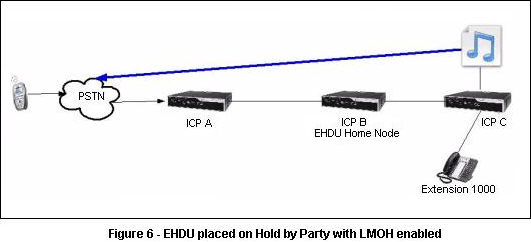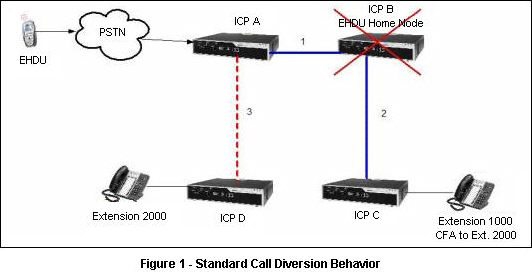
The maximum number of available EHDU External Hot Desk User Licenses is equal to 100% of supported IP users.
System features available to an EHDU are a subset of those available to internal extension users. Use is by feature access code only since there is no support for programmable feature keys on external devices. For a list of supported features, see Using Mid-Call Features and Feature Access Code Support.
An EHDU cannot also be ACD agent.
EHDUs are not allowed to auto camp-on to a busy station
EHDUs cannot receive a Group Page.
When an EHDU is called, the Call Forward - No Answer Timer in the EHDU's Class of Service is started before the call is actually extended to the EHDU. Thus, you need to choose a timer value that allows the system enough time to route the call.
Calls forwarded to an EHDU located in a private network will contain the "forwarded from" information; whereas, calls forwarded to an EHDU located in the PSTN will not.
EHDUs who are members of a Personal Ring Group use the COS and COR of the group's primary member for all outgoing calls and for incoming calls to the personal ring group pilot number. For calls to a member, the EHDU uses its own COS and COR. The Interconnect Restriction used is also the EHDU's own.
Calls to a personal ring group pilot with EHDU members will be forwarded or rerouted based on the primary member of the personal ring group. Calls to EHDU members of the group will follow the EHDU's forwarding or rerouting.
Calls to an EHDU do not support discriminating ringing. Calls from an EHDU, use internal discriminating ringing.
Attendant metering of EHDU calls is supported on calls extended from the EHDU to another PSTN Public Switched Telephone Network. The worldwide analog voice network accessible to all those with telephones and access privileges. destination. In this case, the call metered is the one between the PSTN destination and the EHDU, not the one between the attendant and the EHDU.
The application of ringing tone at regular intervals to signal a waiting message is not supported on EHDU devices. Instead, users hear stutter tone when they log into the system.
External hot desk users can be reached through all trunk types including SIP trunks. See Mid-Call Features below for restrictions on the use of SIP trunks.
System speed calls can be included in the EHDU the external number, provided they are at the beginning of the external digit string. The combination of speed call number and EHDU external number cannot exceed 26 digits.
Outgoing calls to the EHDU are subject to the Bandwidth Management zone information of the originator.
Calls terminating on a private network destination present the CLI Command Line Interface or Calling Line Identification of the EHDU during ringing and after answer. If the EHDU invokes a feature on the private PBX that results in an identity exchange, the originator's display will be updated with the new information.
When an outbound call is made to the EHDU the COR of the outgoing route is checked against the COR of the EHDU. If the COR is restricted, then out-of-service handling is followed; otherwise, the call goes through.
If the caller to the EHDU is an analog trunk with no release supervision, and the call to the EHDU terminates on a analog trunk that also has no release supervision, then the call is disallowed and given out-of-service handling treatment.
Calling line ID (name and extension number) for internal calls to EHDUs is supported on PRI or SIP trunks. An option (Hot Desk External User – Display Internal Calling ID) in the calling party's Class of Service controls whether CLID information displays on the EHDU device.
Only PSTN calls can terminate on a Hot Desk Access number. The calls must be direct dial; transfers are not allowed.
Multiple EHDUs can dial the access number to originate calls. The actual number of users able to originate calls is a function of the DSP resources available to the system.
Incoming EHDU calls are considered in the Bandwidth Management zone of the trunk used by the call.
EHDU calls over IP trunks use digit receivers on the gateway The 'gateway' or interface between two networks of different technology. A kind of "go-between" device or program that passes information between networks that normally couldn't communicate. It is also the entrance into and out of a communications network. Also a Gateway (GW) is an H.323 endpoint that provides real-time communications between an H.323 terminal on a packet-switched network and an ITU terminal on a circuit-switched network. node, not those on the EHDU host node. If any node along the signalling path from the host node to the trunk connected to the EHDU is running an older revision of software, the user will not have access to the mid-call features.
Mid-call features are not supported over SIP trunks.
Where gateway nodes and SIP trunks are used, EHDUs must be provisioned on the gateway nodes in order to log in.
Calls terminating on a private network destination do not have access to mid-call features on the 3300 ICP.
Note: All transit nodes involved in an EHDU call require MCD Release 4.0 or higher for seamless operation.
When an EHDU user
is active on a transit node, the node is treated as an endpoint. As an
endpoint, it acts on DPNSs messages instead of passing them on as expected
since invoking a feature
Normally, when an off-PBX diversion occurs on a network call, the diverting controller sends a divert request to the originating PBX. This request contains the digits required to route to the forwarding destination. The originating PBX then extends the call to the forwarding destination and releases the trunk that signalled the diversion. If the EHDU node that is acting as a transit node does not intercept the diversion request, it will be released when the originating node attempts to divert the call.
Figure 1 shows a call from an EHDU user whose home node is ICP B to extension 1000. Extension 1000 is Call Forward Always to extension 2000. When the diversion occurs, the new call is extended from ICP A to ICP D. ICPs B and C are no longer in the call path which means the state of the EHDU is lost. To solve this problem, the node hosting the EHDU (ICP B) will act as a diversion branching node and will perform all diversion requests as shown in Figure 2.

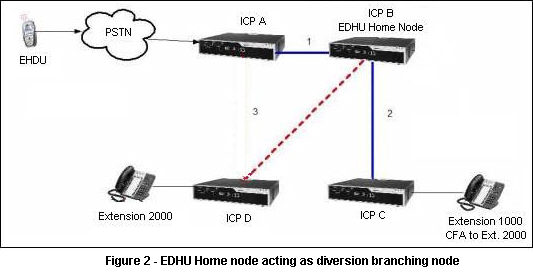
Standard transfer signalling in a DPNSS network causes an exchange of the end point identities. When an EHDU user is active on a transit node, the messages containing the transfer information is passed and the endpoint PBX exchanges the users' PSTN identity, and not the internal identity. This is because the PSTN gateway is not aware that the call is an EHDU and does not have the internal name and number to send back in the identity exchange (shown in Figure 3). To remedy this situation, the node hosting the EHDU will exchange the transfer signals as shown in Figure 4.
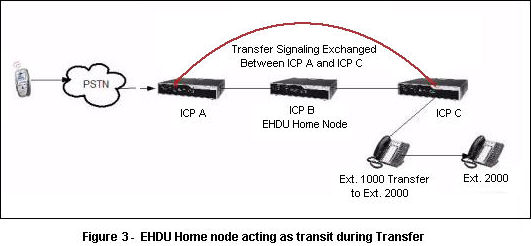
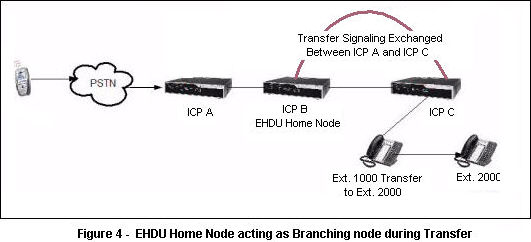
When a caller in the network places an EHDU on hold, the EHDU hears the music source of its home node, as shown in Figure 5, and not the PSTN gateway node as expected in the typical DPNSS transit case.
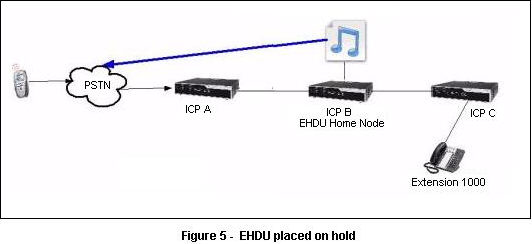
If the holding party has "Local Music on hold source" (LMOH) enabled in their Class of Service, the EHDU user will hear the music source of the holding party's ICP as shown in Figure 6.
